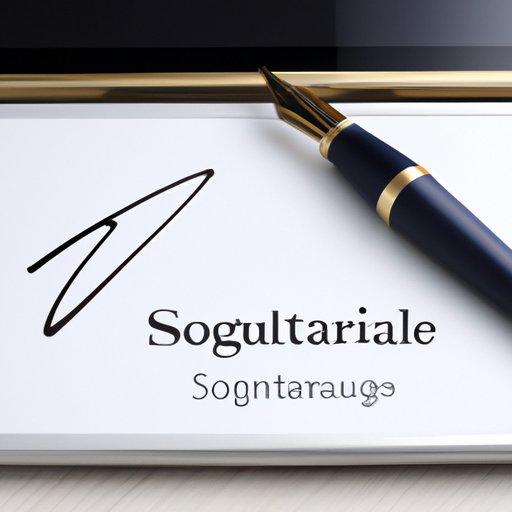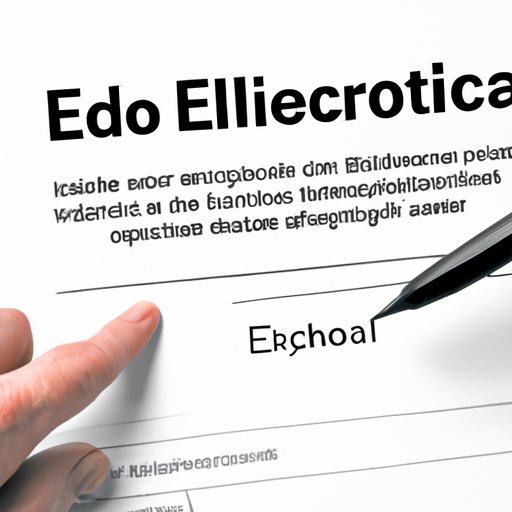
Introduction
In today’s fast-paced world, the need for quick and efficient document signing has become more pressing than ever. Traditional paper and ink signatures have become outdated and are no longer practical in many cases. With the rise of technology, the ability to sign documents electronically has become the norm, but it can still be a confusing and frustrating process. In this article, we will guide you through the process of electronically signing a document and explain the benefits and legality of using electronic signatures.
A Step-by-Step Guide on Electronically Signing a PDF Document
PDF documents are the most commonly used format for electronic signatures. They are popular mainly because they provide a secure and unchangeable platform for signing documents. Here is a simple step-by-step guide on how to sign a PDF document using a computer:
- Open the PDF document that needs to be signed with Adobe Acrobat Reader or any other software that can read PDF files.
- Click on the “Fill & Sign” button in the right-hand pane.
- Click the “Sign” button in the toolbar at the top of the page.
- Select “Add Signature” from the drop-down menu.
- Draw your signature with your mouse or upload an image of your signature.
- Click “Apply” to add the signature to the document.
- Save and send the signed document to the intended recipient.
It is important to note that other software options, such as DocuSign or HelloSign, can also be used to sign PDF documents. The process may differ slightly, but the basic steps remain the same. It is important to follow the specific instructions provided by the software to ensure a successful signing process.
How to Use Digital Signatures for Secure and Efficient Document Signing
Digital signatures are a type of electronic signature that utilizes encryption technology to provide added security in document signing. Digital signatures are more complex, and therefore, there is an added need for security protocols. Digital signatures rely on private and public key encryption to ensure that signatures are not copied or duplicated. A document signed with a digital signature is considered by most regulatory organizations to be safer and more secure than other types of electronic signatures, making digital signatures an ideal option for individuals or companies looking for a more secure and safe option for document signing.
Digital signatures are beneficial because they provide greater security and efficiency in document signing. Digital signatures use a process of public-key encryption, whereby the signer’s private key is used to electronically sign documents, providing a trustable and secure electronic signature. Digital signatures also create tamper-evident seals that are far more difficult to reproduce. When using digital signatures, documents can easily be shared online, speeding up the process of signing and document sharing.
The Benefits of Electronic Signatures: Why You Should Switch from Ink Signatures
As mentioned earlier, electronic signatures are the most efficient option for document signing. The benefits of electronic signatures over ink signatures include:
- Convenience: Electronic signatures can be signed anywhere at any time, eliminating the need for in-person signings and the need to mail or fax documents.
- Speed: With an electronic signature, there is no need to print, sign, scan, and upload documents, saving time and speeding up the signing process.
- Cost-effectiveness: Electronic signatures make the process of signing documents virtually free; there is no need for paper, ink, or stamps.
- Reduced paper trail: Electronic signatures reduce the paper trail, making document storage and retrieval more manageable.
Electronic signatures are becoming increasingly common in various industries, such as real estate, healthcare, finance, education, and many more.
The Legality of Electronic Signatures: What You Need to Know
The legality of electronic signatures varies from country to country. However, most countries, including the United States, have introduced specific laws and regulations for electronic signatures, including the Uniform Electronic Transactions Act (UETA) and the Electronic Signatures in Global and National Commerce Act (ESIGN), making electronic signatures legally binding. But it is important to be aware of the laws and regulations surrounding electronic signatures in different countries and industries.
Electronic signatures are not always accepted in all circumstances. For example, in some instances, certain documents, such as wills, codicils, and trusts, may require a wet ink signature. Special laws and regulations may also apply depending on the industry.
To ensure legal compliance, it is essential to keep up-to-date with current laws and regulations and use the appropriate software that is compliant with those standards. It is also a good idea to have a legal professional review any documents that have been electronically signed.
Top Tools and Software Options to Sign Documents Electronically
Here are some of the top software options for electronic signatures:
- Adobe Sign: Adobe Sign is a product of Adobe, which provides easy and secure electronic signatures.
- DocuSign: DocuSign is a popular electronic signature platform used for signing various types of documents.
- SignNow: SignNow provides its users with the flexibility to sign documents using electronically.
- HelloSign: HelloSign is a straightforward and user-friendly option for electronic signatures that allows users to sign documents easily.
- Eversign: Eversign boasts an intuitive user interface and various useful features.
It is recommended that users review the features of each option and choose the one that best suits their needs for electronic signatures.
Common Mistakes to Avoid when Signing Documents Electronically
Some of the most common mistakes people make when signing documents electronically include:
- Forget to include all required information.
- Not reading all instructions carefully before signing.
- Utilizing incorrect email addresses.
- Failing to save a copy of the signed document for future reference.
To avoid these common mistakes, it is important to read all instructions carefully, double-check that all required information is included, and ensure that a copy of the signed document is saved for future reference.

How to Verify the Authenticity of Electronically Signed Documents
Authenticity is essential for financial institutions, government agencies, and other organizations that require proof of identity when enforcing paperwork. To verify the authenticity of electronic signatures, users should use applications that provide a secure environment for verifying digital signatures, such as Adobe Acrobat Reader, which automatically verifies the digital signature with ease. It is essential to ensure that digital signatures can be verified before accepting any electronically signed documents. Users should check that the organization providing the software has been accredited and meets the regulatory requirements of the region they are in.
Conclusion
In conclusion, electronic signatures are the most convenient and efficient option for document signing. With the use of digital signatures, electronic signatures are now considered much safer than traditional signatures due to the high level of security protocols available. However, it is important to understand the legality of electronic signatures and keep up-to-date with current laws and regulations. It is equally important to avoid common mistakes that can cause problems during document signing and to verify the authenticity of signed documents to ensure they are valid and enforceable.




